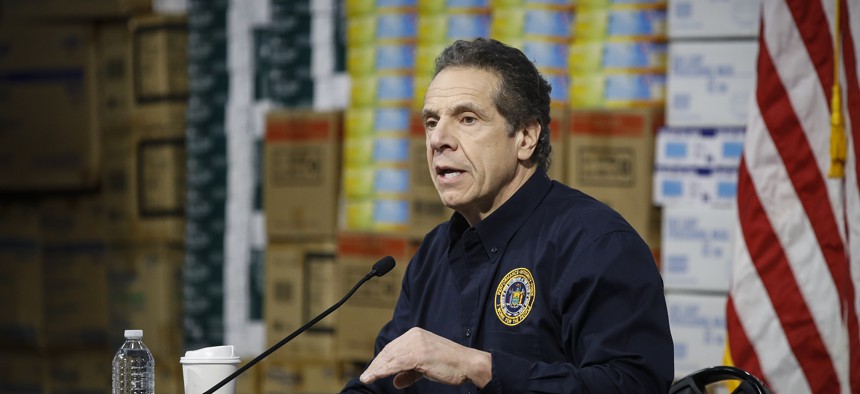Speak Bluntly and Carry a Big Stick: Using Straight Talk As a Crisis Communication Tool

New York Gov. Andrew Cuomo whose brash, empathetic style has become a model for crisis communication speaks at a news conference about the state’s coronavirus response efforts. AP Photo/John Minchillo
COMMENTARY | Governors and mayors are engaging in direct and honest messaging to motivate residents’ responses to the coronavirus pandemic.
“It’s a Big F---ing Deal.”
“Knock it Off.”
“It’s arrogant. It’s self-destructive. It’s disrespectful to other people. And it has to stop.”
Governors and mayors are challenging the conventional wisdom of “speak softly and carry a big stick” amid the Covid-19 pandemic. Instead, they are finding that in some circumstances using blunt, direct language like the examples above helps their messages go much further with their intended audiences.
The bully pulpit has always been one of the most effective tools for public officials. In times of crisis, its value and importance increase exponentially. Recent weeks have put leaders’ communication skills through the most grueling test of their public careers. As they try to emphasize urgency while not inciting panic, governors and mayors are figuring out what is most effective in getting their message across.
“Crisis communication isn’t just about informing people. It’s about creating behaviors that stimulate people to act,” said Hud Englehart, former communications director to former Illinois Gov. Bruce Rauner, in a recent National League of Cities’ webinar. In the earliest stages of the coronavirus response, some state and local officials saw mixed responses to initial social distancing orders—prompting officials to deliver more no-nonsense messages that, perhaps, got more traction.
A mayor in Kentucky, who in an expletive-laden Facebook post implored his residents to understand the severity of the moment by calling it a “big f---ing deal,” became a viral sensation. When Rhode Island Gov. Gina Raimondo told her residents twice to “Knock it off,” a local t-shirt company began producing shirts with the saying and are donating 20% of the proceeds to a local coronavirus response fund. And New York Gov. Andrew Cuomo’s brashness, which he tempers with empathy, has elevated him as a national model of leadership. More importantly, people are practicing more social distancing.
But what makes these types of no-holds barred messages effective?
They are concise and “break through the clutter” of news said Sean Fitzgerald, who leads crisis communications services for Witt O’Brien’s, a crisis and emergency management consulting firm.
These messages also come from a place of understanding. Mike Raia, former communications to Raimondo, used the analogy that these messages remind people of the tone of voice parents and grandparents use to express urgency and concern for people’s wellbeing. Similarly, Englehart said these messages work “for some portion of the population that is more accustomed to being scolded into action, rather than cajoled.”
Critically, these messages are informed by facts from subject matter experts. As Englehart noted, public officials are “blessed or burdened with a lot more information about the hazards than the general population.” That gives them credibility, which as Raia noted is the most essential part of being a trusted communicator.
While bluntness can be a helpful part of the overall communications strategy, that alone will not guarantee effectiveness. Case in point: Texas Lt. Gov. Dan Patrick’s interview with Fox News where he suggested that the elderly were willing to sacrifice themselves for the good of the economy.
Blunt. Yes. Empathetic. No. Fact-based. Definitely not.
Raia said statements like the lieutenant governor’s aren’t as effective because they aren’t “built with paragraphs before that of factual information from doctors and emergency responders.”
Aside from straight talk, leaders also need to ensure that when talking a big game, they can back it up. Raia said that it’s critical for the communications message to have some policy behind it. Part of why governors and mayors saw defiance in their initial push for distance—which in some places was followed by people flocking to beaches and bars—is because those orders lacked government enforcement.
“Walking the talk” will become even more important as we enter new phases of the crisis, Fitzgerald said. Governors and mayors will need to show and not simply tell residents what behaviors to exhibit. This will be particularly valuable as people spend weeks, and possibly months, stuck at home.
With fewer policy decisions to announce and more reported cases of coronavirus ahead, state and local leaders will have to pivot to remain an active presence that encourages residents to stay the course and stay calm. Fitzgerald said that reminding people about why they need to continue to shelter in place will be key to this.
Englehart and Raia also suggested that leaders not only share health data reports in their communications, but find ways to share stories and show appreciation for constituents who are staying home and helping to slow the spread of the virus.
Some of that has already started. Virginia Gov. Ralph Northam tweeted about a boy who is communicating with hotels to donate unused items to hospitals.
Additionally, state and local leaders should consider showing themselves in situations that are similar to those of their constituents as a way to relate to them. Chicago Mayor Lori Lightfoot recently did just that in a public service announcement video that showed her in different situations at home.
Governors and mayors cannot talk their way out of the sober reality of more infections, hospitalizations and death. But through that right mix of directness, empathy and fact-based messaging, they can continue to hammer important messages home and help their residents weather the current crisis.
NEXT STORY: Absent State Action, a Georgia County Forged Ahead






